Russian Insulator Report, 1992
by Don Fiene
Reprinted from "Crown Jewels of the Wire", December 1992, page 12
I had thought my 1989 trip to the USSR would be my last (see my article in
Crown Jewels of the Wire, November, 1989), but somehow I managed to get a grant
from an organization called IREX (International Research and Exchange Board) to
do research on certain Russian icons of the type known as Divine Wisdom. From
March 2 through May 30, 1992, I lived in an ordinary one-room Russian apartment
in Moscow -- short on light bulbs and laundry facilities, but long on
cockroaches!
I bought my food from dealers on the street. It tasted okay, but I
lost fifteen pounds on it. I visited three other cities, including St.
Petersburg, but mostly worked in Moscow. Usually I had the weekends free. On
Saturday, I would visit the huge flea market in Izmailovsky Park, where
thousands of dealers sold everything imaginable -- from Russian coins to Turkish
rugs, from holy icons to portraits of Stalin -- but no insulators. However, I found a dealer whose specialty was U.S. military insignia; I
told him I would
trade a bag of the stuff (that I bought cheap in U.S. flea markets) for three
or four glass power insulators. He was interested. He knew exactly what
insulators were. He said he would come by and look at my insignia within a
couple of weeks.
On Sundays, I would take long walks on railroad tracks,
usually starting in the huge yards behind one or another passenger railroad
station. I returned to the Riga Station yards which I had explored in both 1988
and 1989 and again found several boring brown porcelain insulators on the
ground. However, I saw plenty of excellent glass power insulators overhead (see
photo 3, left, and Figure 1), about half of which had been broken over the years
and replaced with porcelain. These insulators were attached in threes to a
z-shaped wooden rack fixed to the outer portion of iron poles. The primary function of the poles was to support the
cables from which
the wires providing power for electric trains were hung. Here one saw masses of
large porcelain insulators.
In or near the yards all trains were electric; a
large yard might be fifty tracks wide -- so that all you could see in all
directions were these huge dirty brown insulators. Within a mile beyond the
yards, all major passenger and freight trains had switched to diesel; only
commuter trains (operating within thirty miles or so of the city) remained on
electric power. And it was only on the poles beside these commuter tracks that
one occasionally saw glass insulators. There would be stretches of several miles
where such insulators were not seen at all; nor were they to be found close to
the train stations. This special power-line installation would usually begin
about one kilometer from the station. (In trying to figure all this out, walking
along with my head in the clouds, I nearly got killed about three times. Once I
got trapped on a bridge over a city boulevard, with a massive silent passenger
train gliding past me about eighteen inches from my behind.) I'm not sure what
these power lines were for. Perhaps they had something to do with signals. In
any case, out of all the millions of power-line insulators associated with
Russian railway lines, only a relative handful are glass. Of these, I have seen
no more than ten types (including minor differences, colors). As for
power-distribution lines in general, very few employ glass insulators, though
sombrero-type insulators remain common.
This year for the first time, after twelve trips to Russia, I had a good map
of Moscow showing all railroad tracks and train stations, as well as bus and
subway stops, etc. This allowed me to draw a small, accurate map for each of my
walking trips. The whole point was to try to guess in advance where the odd-ball
power lines would show up -- so I wouldn't have to do so much dangerous hiking. As
for trespassing on railroad property, no cop ever said a word to me on the
subject. This was just one of those minor crimes that are prosecuted in New York
City or London, but not in Moscow, where every train yard is criss-crossed with
pedestrian paths.
As far as I can determine, Moscow has eight major train
stations, all terminals, and all named for a city or region, although each
station serves many other cities than the one it is named for, some much
farther away than the implicit destination. Moscow's stations are as follows,
proceeding clockwise from the west: Keiv, Belorussia, Riga, Leningrad, Yarslovl,
Kazan, Kursk and Pavelets. These stations are situated along an approximate
circle some distance from the center of the city, though all remain in
completely urban locations. All are connected by a complex network of tracks,
but no track crosses the center of the city. All were built in the late
nineteenth century and all are of fantastic, baroque design. Eventually I
inspected all these stations and their track systems.
Insofar as I lived only
three subway stops from Belorussia Station, I explored that areas with special
diligence. On my first day in that region I made my way to the main line north of
the station by way of a street called Butyrsky Val. It ran parallel to the tracks,
with a steep slope extending down to them. About two-thirds down the slope a
line of ancient metal poles ran parallel to the tracks for a distance of
approximately 500 yards. From the street, the top part of the poles seemed only
a few feet away. All carried the special z-shaped bracket described above. I
climbed down to the first pole and at the base of it found an amber glass power
insulator (see Photo #2,far left, and Fig. 3) in mint condition -- the first and
last Russian glass insulator I ever found in this manner. I felt like a very
lucky boy. I felt like I had just picked up a $500 bill off the sidewalk. Next
to my mint insulator was a broken one. On the wooded bracket above (attached to the pole) was a third
amber insulator. It looked mint, and there was no wire attached to it. I walked
to the end of the line of poles and determined that the wires were either down
or dead the whole distance. As far as I could tell, the remaining insulators
were either amber glass or brown porcelain, and all mint. I could have climbed
the poles, but I was afraid to. For one thing, I would have been visible to half
of Moscow as it raced down Butyrsky Val scarcely thirty feet away. For another,
these insulators, like most in Europe. would have been screwed down tight with
cloth or string jammed in the threads. It would take some Tarzan to unscrew them
while leaning out from the pole to the far end of the bracket. Therefore, I was obliged to find the organization responsible for these poles and
ask them to give me all the insulators they could spare.
|
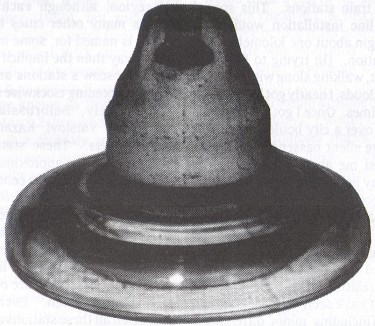
|
| Photo 1. Sombrero type. Internal key pin is short so that the insulator sits
flat. |
 |
|
Embossing=> |
For the next two or
three weeks, whenever I was out walking the tracks, I would ask any workman I
saw to tell me the name of the railway agency responsible for high-voltage
lines. (Or, more commonly, I would simply point to the type of insulator I
wanted and demand, "who do I ask to get one of those?" Often I would
show them pictures of my insulator collection, to keep from being thought of as
crazy.) Finally, I was able to figure out that the places responsible for poles,
wires and insulators were called Energy sections (like the railroad divisions in
the U.S. where "section gangs" worked) Energo-uchastki in Russian, a
term that most railroad workers did not seem to understand. As for getting the
address of one of these places, this seemed hopeless. However, one railroad
foreman finally explained to me that Energo-uchastok No.7 was located near
commuter station Pokrovskoe-Streshnevo -- the fifth stop on the line running northwest from
Leningrad Station. Though I more or less understood the foreman's words, I had
no clear idea what they meant, nor could I fathom how to find any commuter
station anywhere in the city (being totally unfamiliar with Moscow train
schedules) and determine its place in a sequence of stations. And I did not see
how my map could help me with this. Above all, I was puzzled by the name Pokrovskoe-Streshnevo. It sounded like a fourteenth-century church or something,
and I did not seen how it could be related to a railroad station. I had just
about given up on this approach to my problem. when my eye happened to fall on
this very place name in the middle of my huge map of Moscow. It was all so
incredibly accidental that I could only suppose that God was behind it. Anyway.
I quickly learned to read my map for commuter stations, which were marked by
special symbols; I saw at once that Pokrovskoe-Streshnevo was indeed the fifth
commuter stop out of Leningrad Station, and I made immediate plans to go there.
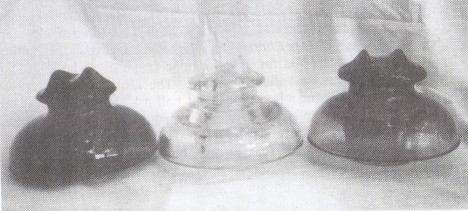
Photo 2. Three variations if CD 247.5. Left to right: dark amber, ice green,
aqua.
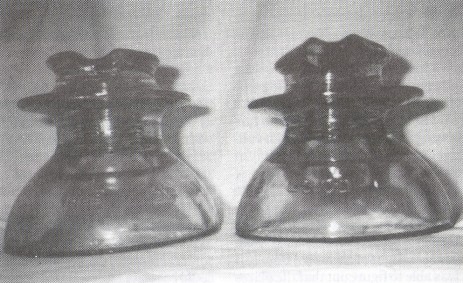
Photo 3. These light green power insulators are both CD 638. The variant
on
the left has a flat top while the variant on the right has rounded ears.
Meanwhile, the flea-market dealer (who proved to be a college student named Igor
Ulianov) had come by once to look at my military stuff. He liked it all and said
he would be back with insulators. However, all he ever brought me was a
sombrero-type insulator (see Photo #1). I refused to trade him for it because it
was so heavy -- I didn't think I wanted to try taking it home; also, it might
irritate the customs inspectors. But I kept it with the idea that if I got no
other insulators, then I would probably trade for the sombrero in the end.
However, I never saw this dealer again -- indicating that glass insulators are hard
to find in a big city like Moscow.
It was a raw cold wet day when I set out for Pokrovskoe-Streshnevo. (But this
was nothing new; it was like that every day until the last two weeks in May.)
When I got to the little commuter station, I asked the ticket-taker how to get
to Energo-uchastok No.7. She hadn't a clue as to what I was talking about, but
she was kind enough to telephone several of her colleagues in the vicinity until
she found one who knew the score. The ushastok proved to be about half a
kilometer away at the extreme edge of the yard, which had narrowed to about
eight tracks at that point. As I approached the large open gate leading into the
place, I saw insulators scattered everywhere on the ground. True, they were all
porcelain. But I liked the look of them. The enclosed areas of the ushastok included four or
five shops and warehouses. I knocked on the door of
a small office building (or shack). A foreman-type guy came out, listened to my
story, looked at my insulator pictures and led me over to a five-foot-high pile
of bright green glass power insulators (see photo #3, right, and Figure
2).
About half of the insulators were broken; the other half were mint. I felt faint
with greed.
Meanwhile, two more workers had joined us. They wanted to see my
insulator photos, too. And then the manager approached, demanding to know what
was going on. The foreman whose name was Anatoly said he was going to give me
some insulators. The manager said, "We don't give things away here!"
But when he learned I was an American, he said I could have all the insulators I
wanted.
We all chatted about life and politics for quite a while, but finally the
foreman asked me how many green insulators I could use. I said I could use about
five. We picked out five mint pieces and placed them in two plastic bags I had
thoughtfully brought along. Then I gave Anatoly a bottle of vodka that I had
brought with me as well. He in turn gave me two white porcelain insulators of unusual design
(see photo #4, 1st & 3rd from left, & Fig. 4 & 5). I
asked him about the amber insulators I had seen near Belorussia Station. He said
that that line was in the territory for which Uchastok No.8 was responsible. He
drew a sketchy little map, showing me how to find the place. I took a trolley
car back to my pad, clutching my precious cargo. I felt like a really lucky guy
who had just found $2500 on the ground.
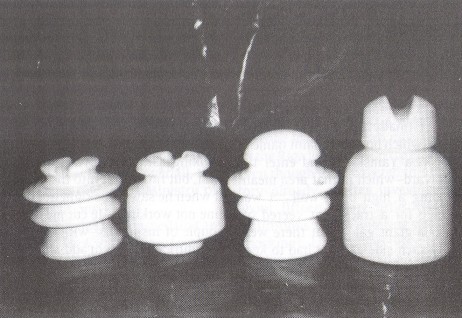
Photo 4. Pin-type white porcelain insulators.
|
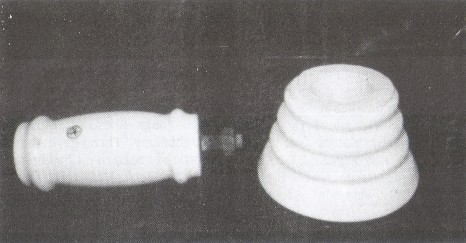 |
Photo 5. (Left)
Strain type insulator for trolley car support wires.
Length
(porcelain only) = 5"
Smallest diameter = 1- 7/8"
Largest diameter = 2-
1/8" |
(Right) Found in China (type
unknown)
Has Russian mark:
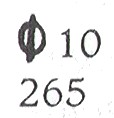
Height = 3"; Top diameter = 2-3/4";
Bottom diameter = 4-1/2" |
It took me several attempts to find Uchastok No.8. From the street side there
were no signs or house numbers and the various sheds and buildings -- some of
considerable stature -- were of every sort, by no means related to railroad
property. I felt totally frustrated -- as though I had been dropped down into
12th-century Shanghai with the task of finding a particular opium den. I finally
had to abandon the street (which bore the quaint name of Tverskaia Yamskaia) and
enter the train yard -- which in that area meant climbing a high brick wall. I was
looking for a track that veered off under a giant gate. But there were many such
side exits. I had to keep banging on the wooden gates until I found the right
one. A worker took me to the office of the assistant director, a decent
guy with the poetic name of Ruslan Yevgenievich. He was amazed that I had been able to find his place of work. And he found my
photographs intriguing and my story about the amber insulators worth looking
into. He said to return the next morning at nine and he would assign a worker
and a foreman to obtain some insulators for me.
My worker proved to Tolya (short
for Anatoly) and his straw boss, Volodya (short for Vladimir). The dead power
line was within easy walking distance. Tolya grumbled at first, but finally got
into the spirit of it when he saw I was right about the line not working. He cut
me loose a couple of insulators -- with considerable difficulty, I might add; they
were really screwed on tight; furthermore, the tie-wire was very hard to cut. I
could see that Tolya's tools were far inferior to the ones I had brought from the
States.
While inspecting my newly-acquired insulators, I noticed that one of them was
actually green; the thick layers of carbon had made it seem amber from the
ground. I persuaded Tolya to take down a few more pieces for me, ending up with
four more amber (besides the one I found) and two green insulators (all of CD
247.5; see photo #2, left & right, & Fig. 3). Again I had the pleasant
experience of seemingly finding about six five hundred dollar bills in my path.
Tolya, meanwhile, had become interested in salvaging the abandoned wire. He and
Volodya eventually took it all down and carried it back to their shop in rolls.
They felt especially proud of themselves because the wire actually belonged to
Uchastok No. 11, whose territory extended just past the poles to the track,
where No. 8's terrain began. I gave Volodya a small bottle of vodka and asked
him to pass it on to Tolya. When we returned, these two disappeared and Ruslan
was nowhere to be found. I asked his secretary for a letter head, hoping that
such an official paper could help me get a ton or two of insulators through
customs. (The official stationery gives an address at Belorussia Station, then
specifies the Moscow-Smolensk Section of Energy Supply, which is part of the
Moscow Railroad over all, the whole being under the Ministry of Communications.
)
By this time I had learned that an important uchastok was located somewhere in
or near the vast Leningrad Station yards, a major repair center in addition to
much else. I was hoping I could find there some large amber glass insulators I
had seen on my railroad hikes that were nine inches or more in diameter. I walked
through the yards two or three times, found nothing. What little information I
got from querying workers proved contradictory. The situation was complicated
by the fact that Yaroslavl Station sits cheek by jowl with Leningrad Station,
and their yards merge. There are places where you would have to cross fifty
tracks to traverse the entire yard. It was a monstrous, dangerous place. And
frustrating. Finally I went to the Leningrad Station Trainmaster's office.
Surely he should know the location of this uchastok. He wasn't in, but his
secretary was. She occupied a huge office and obviously wielded great power. But
even she did not know what an uchastok was; she had to call several people
before getting a definitive address; it was near the Rzhevsky commuter stop. I
knew exactly where that was.
It was an hour's walk away by rail, and I walked it -- even though it was getting near lunch. The workers I encountered there had
no knowledge of an uchastok at Rzhevsky station -- but one insisted there was an
energy section very near Leningrad Station, while another swore there was one in
addition two miles north on the Riga line. I decided to go north even though I
had covered this territory already. After investigating about fifteen funny
little railroad institutions (often entering without knocking), I found the
place I was looking for. I wandered around inside until I came upon the whole
staff in their cozy little kitchen eating lunch. The boss was there too. He
listened to my story and he loved it.
He immediately assigned me a guide named Erik (though by then I would have
preferred lunch). Erik told me I could have any insulator I wanted, but there
was a smallish porcelain strain type (see photo #5, left). I had already found
several white porcelain insulators on my own during my walks. (See, for
instance,
photo #4,far right, and Fig. 6) Some of these I kept, others I tossed. Erik
turned out to be a collector, too: of 19th-century musical manuscripts. He said
he would call me if he spotted one of the large amber pieces I craved, but I
never heard from him. Later I saw more of these insulators on the Kiev line, but
did not have the time to locate any "energy sections" in that area
before leaving the country.
One of the most exotic walks I took was that
proceeding out of the Kazan Station yards toward the east -- toward Siberia. During
the course of three or four hours, early on a Sunday afternoon, I encountered
trains heading for or arriving from the following fascinating cities located all
over Siberia and Central Asia: Cheboksary, Shiguli, Serdach, Mordovia, Penza, Ufa, Cheliabinsk, Barnaul, Samarkand, Khabarovsk and Tomsk. Incidentally, you
know where trains are going in Russia because they all have ornate, red, white
and blue destination signs made of steel on each car. (Perfect collectors'
items.)
Meanwhile, the location of the Leningrad Station uchastok eluded me
until I walked down into the middle of the yards where a large locomotive repair
center loomed up. This time, when I queried an old foreman, he was able to point
directly at my uchastok about half a kilometer away. The "energy
section" was actually at the intersection of the Leningrad and Yaroslavl
yards, located on a dirt road that began as an alley between the two station
buildings and was virtually invisible at that point.
The place was enclosed by a
red fence about seven feet high; a small sign identified the area, somewhat
unexpectedly, as Energo-set No. 34-1 (meaning "Energy Network"). I had
to ring a bell to get service. Eventually a young guy about twenty came to the
gate. His name was Misha. He listened to my story and looked at my pictures. He
immediately took me around his "network," looking in every possible
cranny for insulators. I picked up one white porcelain type and kept it. (See
photo #4, 2nd from left, & Fig. 7) We ended up at a pile of large green glass
insulators, many broken, looking quite like the stack at Uchastok No.7. I decided not to be greedy and took just one. As it turned out, that day was
Misha's twenty-first birthday. Several of his co-worked had bought him a bottle
of vodka. I was invited to sit with them around their kitchen table and have a
drink. It was right close to quitting time. We drank toasts to each other and to
world peace. Misha gave me a full name (Mikhail Anatolievich Kalashinokov) and
his telephone number (262-9522), and said if I wanted more insulators I should
call him. He also said he would look around for one of the nine-inch amber glass
insulators that he had often seen on the lines.
When I got home I compared my new insulator with the other large ones I already had and saw that it was a
lighter green and that the upper part was of a quite different design (see
Photo
#3, left, & Fig. 1). So I would have to get more insulators from Misha later
in the week. I felt a little embarrassed about this, but I did it anyway. I
almost got lost again trying to find the elusive Energo-set' No. 34-1. Misha
answered my ring. I asked if he could spare three more of the green glass. He
said, "Sure!" So that made a total of four more power glass insulators
during the week -- like getting a check in the mail for two grand. Misha had not
been able to find any of the large amber insulators. And spares had probably
disappeared decades before.
Packing my things to leave Russian was the usually
hellish agony. I felt morally obligated to take most of the insulators home; I
had chosen twenty-five, leaving only a few brown porcelain behind. (I got one
last white porcelain piece from a Russian friend who found it in China -- (see
photo #5, right); but it has a Russian embossing.) First I filled a medium-sized
cardboard box with insulators (including the heavy sombrero and all the
porcelain, with the common pieces on top) and then placed four glass power in
each of the two large suitcases and three power in a small one. Each of the four
pieces of luggage was so heavy that I could barely lift it, let alone carry it
along while walking.
Meanwhile, I had the usual problem of contraband -- items
that must lawfully be declared to customs. but that I did not intend to
declare; a valuable Russian icon, Russian coins from the 18th century, current Russian
paper money, Russian stamps for collectors and various art objects and books
about art. I did not want the insulators to alert customs to these other things,
yet there was no way the insulators could be overlooked. I was worried. In
addition, I had picked up fifteen slide rules, two of them two feet long (very
rare), to add to my considerable collection of these at home. This seemed a
potential source of trouble -- likewise the four dug bottles I bought at the flea
market, all more than 100 years old. And so on. Some of the stuff I was about to
"hide", but that was mostly hopeless.
Consequently, I was just as
anxiety-ridden in 1992 as I had been during all my other dozen departures from
Russia in the past 25 years. However, I tried not to be stupid. For one thing, I
fixed up my box of insulators so that it could easily be opened by cutting
through the tape holding the top flaps in place. Meanwhile, I had left the rope
that come up from the sides very loose-in a double loop that served as a handle.
As I approached the customs officer, I pushed the box onto the conveyor belt
first. The X-ray detector was unfortunately working perfectly. The customs guy
immediately called me over. We had a conference. I described my hobby, opened
the box, and took out the most innocent-looking porcelain item in it. Mr.
Customs smiled cheerfully at this well-known white object and waved all my stuff
on through without opening anything. What a beautiful piece of luck! And I was
able to drag the. box out of the way very quickly and re-tape it later. I was
eventually allowed to take it with me on the plane.
However, the main purpose of
my trip was not collecting insulators, but photographing icons; I brought home
25 rolls of exposed film. I was able to get at least one publishable slide for
each of the 100 icons found in the archives of twenty or more museums, libraries
and cathedrals. I have already been tentatively invited to return to Moscow for
two weeks in the summer of 1994. If I do in fact go back, I will spend what
little free time I have searching for examples of the nine-inch amber power
type. Probably this item is the same as that designated as CD 304.5 by Marilyn Albers and N.R. Woodward in their book
Glass Insulators From Outside North America, First Revision, 1986. However, that insulator is lime green, not
amber, and is dated 1976. There is only one example in the U.S., and it was
broken and glued. As for the amber type, I have seen hundreds of them,
especially on the railroad lines going out of Kiev Station; and I know the
approximate locations of three different uchastki connected with that track
system. Perhaps in one of them, in some dark corner overgrown with weeds, I will
find, let's say, about five of these rare insulators. I hate to think what I'll
have to charge for them at the following National Insulator Association
Convention.
|
